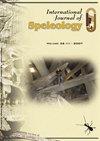反向伪窟窿:在内尔哈洞穴(西班牙东南部)观察到的一种新的叶片亚型
IF 1.3
4区 地球科学
Q3 GEOSCIENCES, MULTIDISCIPLINARY
引用次数: 0
摘要
在西班牙南部的内尔哈洞穴观察到并描述了一种名为 "反向假沟 "的新亚型叶片。它由相当垂直的薄壁(高约 5 毫米,厚约 2 毫米)组成,形成于亚水平表面(搁栅石)的下方,生长方向与正常的沟(边缘石坝)相反,形成蜿蜒曲折的形状。它们的矿物成分主要是碳酸钙,不过也发现了由粘土和磷酸盐矿物组成的球状集合体。这些反向假水沟的生成和演化正好发生在水气界面,并受以下因素控制:(1)形成假水沟的地表处于次水平状态;(2)方解石过饱和度从稀缺到非常稀缺;(3)水位逐渐缓慢下降。因此,当叶片发育在近乎水平的天花板下方,且进水饱和度极低时,反向假面代表了叶片达到的形状极限。虽然只在内尔哈洞穴中观察到了这种新的叶片亚型,但由于控制其发展的因素并不十分严格,因此极有可能存在于世界上其他一些洞穴中。本文章由计算机程序翻译,如有差异,请以英文原文为准。
Reverse pseudo-gours: a new sub-type of folia observed in the Nerja Cave (SE Spain)
A new sub-type of folia named “reverse pseudo-gour” has been observed and described in the Nerja Cave, southern Spain. It consists of fairly vertical, thin barriers (about 5 mm high and 2 mm thick) that develop on the underside of a sub-horizontal surface (shelfstone) and grow in the opposite direction to normal gours (rimstone dams), generating sinuous shapes. Their mineral composition is essentially calcium carbonate, although globular aggregates composed of clay and phosphate minerals have also been identified. The genesis and evolution of these reverse pseudo-gours occur just at the air-water interface and are controlled by (1) the sub-horizontality of the surface on which they develop, (2) scarce to very scarce calcite supersaturation, and (3) progressive and slow lowering of the water level. Thus, reverse pseudo-gours represent the shape limit to which a folia reaches when its development occurs just below a nearly horizontal ceiling and the feeding water saturation is extremely low. Although this new sub-type of folia has only been observed in the Nerja Cave, it is highly probable that it exists in several other caves around the world because the factors controlling its development are not very strict.
求助全文
通过发布文献求助,成功后即可免费获取论文全文。
去求助
来源期刊

International Journal of Speleology
地学-地球科学综合
CiteScore
3.10
自引率
23.10%
发文量
12
审稿时长
>12 weeks
期刊介绍:
The International Journal of Speleology has the aim to get cave and karst science known to an increasing number of scientists and scholars. The journal therefore offers the opportunity to all scientists working in and on karst to publish their original research articles or their review papers in an open access, high quality peer reviewed scientific journal at no cost. The journal offers the authors online first, open access, a free PDF of their article, and a wide range of abstracting and indexing services.
 求助内容:
求助内容: 应助结果提醒方式:
应助结果提醒方式:


